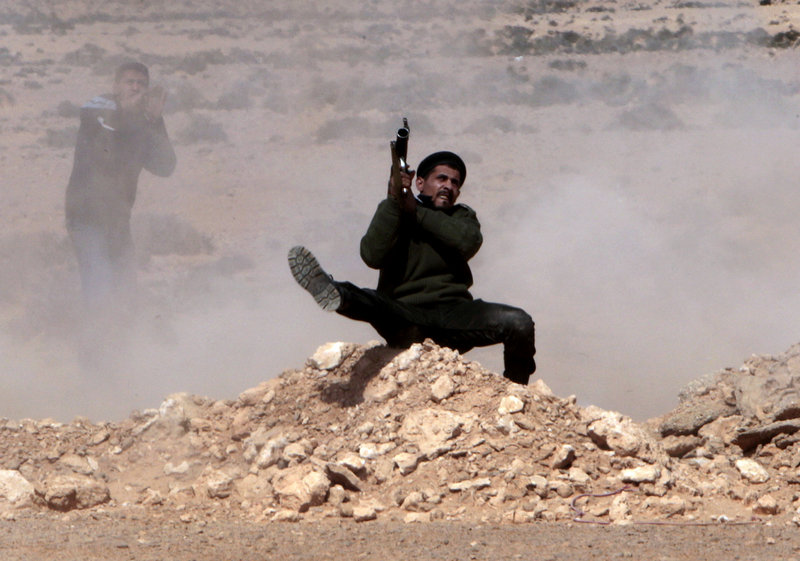RAS LANOUF, Libya – The world moved a step closer to a decision Saturday on imposing a no-fly zone over Libya, but Moammar Gadhafi’s troops were swiftly advancing on the poorly equipped and loosely organized rebels who have seized much of the country.
Gadhafi’s forces pushed the front line miles deeper into rebel territory and violence erupted at the front door of the opposition stronghold in eastern Libya, where an Al-Jazeera cameraman was slain. He became the first journalist killed in the nearly monthlong conflict.
In Cairo, the Arab League asked the U.N. Security Council to impose a no-fly zone to protect the rebels, increasing pressure on the United States and other Western powers to take action that most have expressed deep reservations about.
In surprisingly aggressive language, the 22-member Arab bloc said after an emergency meeting that the Libyan government had “lost its sovereignty.” It asked the United Nations to “shoulder its responsibility … to impose a no-fly zone over the movement of Libyan military planes and to create safe zones in the places vulnerable to airstrikes.”
Western diplomats have said Arab and African approval was necessary before the Security Council voted on imposing a no-fly zone, which would be imposed by NATO nations to protect civilians from air attack by Gadhafi’s forces.
The United States and many allies have expressed deep reservations about the effectiveness of a no-fly zone, and the possibility it could drag them into another messy conflict in the Muslim world.
Gen. Abdel-Fattah Younis, the country’s interior minister before defecting, told The Associated Press that Gadhafi’s forces had driven farther into rebel territory, past the refinery at Ras Lanouf. They were now just 25 miles outside Brega, the site of another major oil terminal.
Fewer rebel supporters were seen by an Associated Press reporter farther east, suggesting morale had taken a hit as the momentum shifted in favor of the regime.
Outside the rebel stronghold of Benghazi, Al-Jazeera cameraman Ali Hassan al-Jaber was killed in what the pan-Arab satellite station described as an ambush.
Correspondent Baybah Wald Amhadi said the crew’s car came under fire from the rear as it returned from an assignment south of Benghazi. Al-Jaber was shot three times in the back and a fourth bullet hit another correspondent near the ear, Amhadi said.
“Even areas under rebel control are not totally safe,” he said. “There are followers, eyes or fifth columns, for Col. Gadhafi.”
The Libyan government took reporters from the capital, Tripoli, 375 miles east by plane and bus to show off its control of the former front-line town of Bin Jawwad, the scene of brutal battles six days earlier between insurgents and Gadhafi loyalists using artillery, rockets and helicopter gunships.
A police station was destroyed, its windows shattered, walls blackened and burned, with broken furniture inside. A school had holes in the roof and a wall. Homes nearby were empty and cars were overturned or were charred hulks in the road.
Rubble filled the streets and a sulfurous odor hung in the air.
The tour continued 40 miles to the east in Ras Lanouf, an oil port of boxy, sand-colored buildings with satellite dishes on top.
The area was silent and devoid of any sign of life. A playground was strewn with bullet casings and medical supplies looted from a nearby pharmacy whose doors had been shot open.
The defeat at Ras Lanouf, which had been captured by rebels a week ago and only fell after days of fierce fighting and shelling, was a major setback for opposition forces who just a week ago held the entire eastern half of the country and were charging toward the capital.
A column of black smoke billowed from Ras Lanouf’s blazing oil refinery. A Libyan colonel asserted the rebels had detonated it as they retreated.
Send questions/comments to the editors.



Success. Please wait for the page to reload. If the page does not reload within 5 seconds, please refresh the page.
Enter your email and password to access comments.
Hi, to comment on stories you must . This profile is in addition to your subscription and website login.
Already have a commenting profile? .
Invalid username/password.
Please check your email to confirm and complete your registration.
Only subscribers are eligible to post comments. Please subscribe or login first for digital access. Here’s why.
Use the form below to reset your password. When you've submitted your account email, we will send an email with a reset code.